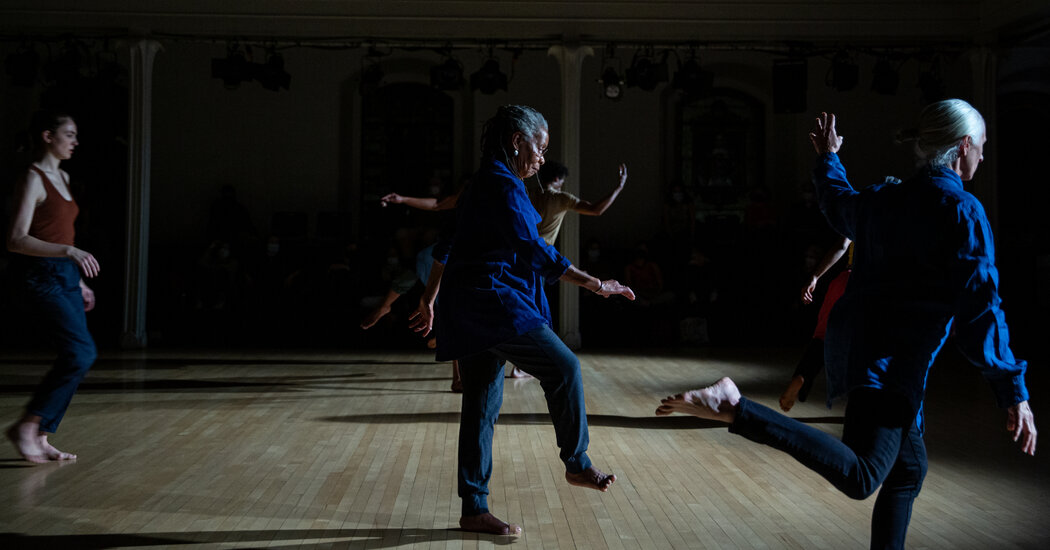History is integral to Danspace Project’s 50th-anniversary season. As part of “Danspace@50: The Work Is Never Done. Sanctuary Always Needed.,” a four-month festival of performances, screenings and conversations, spring programs pay homage to an older generation of dance artists with fresh takes on notable works from their careers.
Dances can never really be brought back as they were. They exist in bodies, and each generation has a singular approach. How can the past be braided into the present? By bringing new dancers into the process, as works by Ishmael Houston-Jones and Fred Holland, Bebe Miller and Donna Uchizono have done. (In May, Marjani Forté-Saunders will present Blondell Cummings’s “Chicken Soup,” from 1981.)
Here is a closer look at the offerings so far.
Ishmael Houston-Jones: ‘OO-GA-LA Reimagined’ (Feb. 27-March 1)
In 1983, at a Danspace festival of contact improvisation, Ishmael Houston-Jones and Fred Holland came to break the rules and make their own. Most of the directives they wrote for their improvised duet “OO-GA-LA” were contrary. Since contact improvisation was normally done barefoot, they would wear punk boots; since it usually aimed for sequential flow, they would veer away from that and even avoid physical contact. But the start of their rule-breaking rule sheet was a simple assertion of difference: “We are Black.”
For “OO-GA-LA Reimagined,” the young Black artists Stephanie Hewitt, Kris Lee and AJ Wilmore created their own manifesto, identifying themselves as shape-shifting tricksters who would both revere their ancestors and “bite back.” That’s what they did, after footage of the original was projected and Houston-Jones danced a benedictory opening solo. (Holland died in 2016.) The 1983 performance, for all its radicalism, was subtle in its protean shifts; the new version was more flamboyant and freewheeling.
The three threw themselves around uninhibitedly, bouncing off, obstructing and pumping one another up. Much of their playful energy emanated from their turns at a D.J. station, mixing in classic dance tracks and gospel. Apart from their touching veneration of Houston-Jones, the spirit was irreverent — the best tribute. BRIAN SEIBERT
Donna Uchizono: ‘Dedications/State of Heads’ (March 13-15)
Before the presentation of Uchizono’s “State of Heads” (1999), she took to the stage for a long-winded chat in which she spoke about her ties to Danspace Project and her love of dancers, whom she called “the giantesses and the giants of our field.”
“We balance on their backs,” she said.
The program started with two such giants, Jodi Melnick and David Thomson, who took turns performing impromptu “Dedications” for two randomly selected audience members. The heartfelt improvisations should have been a stark contrast to “State of Heads,” a trio concerned with political alienation. But both parts lacked sufficient tension. For “State of Heads,” three new dancers joined Rebecca Serrell Cyr, Levi Gonzalez and Uchizono, whose premise, seen in the performers’ bobbling heads and disjointed changes of direction, was that heads of state were disconnected from the body of the nation. It’s scary when satire becomes more of a reality over time.
But what used to be searing now seemed like a warm bath, as it slipped into self-conscious reverie. The best part of the work was sonic — James Lo’s score with its shocking opening boom. The work’s precision, once severe, was harder to discern, and the setting was all too beige. Ghosts of its former glory resonated in Serrell Cyr, sharp as ever in her rendition of an eerie mechanical doll, while Tim Bendernagel, a new addition, was eye-catching for the scale of his dazed efficiency. Yet aside from Lo’s scorching sound design, performed live, this new “State of Heads” wasn’t menacing enough. GIA KOURLAS
Bebe Miller Company: ‘Vespers, Reimagined’ (March 27-29)
“I didn’t know how to do this back then,” Bebe Miller said near the start of “Vespers, Reimagined.” Back then was 1982, when she performed her improvised solo “Vespers” at Danspace Project as part of Parallels, a series organized by Houston-Jones to gather Black choreographers working in experimental dance.
Now she knows. In “Vespers, Reimagined,” she led an exceptional cast of much younger dancers (Bria Bacon, Jasmine Hearn, Shayla-Vie Jenkins, Chloe London and Stacy Matthew Spence) through an absorbing blend of improvisation and set choreography. Two dancers might make prayerful motions in loose unison as two others interfered like benignly meddlesome ghosts. Then the unison would fray or dissolve into solos, both simultaneous and singled out. Because of the format, the contrast between Miller and her colleagues was blurred, yet it remained legible. Miller’s improvisations and most of the choreography had a soft-jointed gentleness characteristic of her and her generation. The younger dancers ran hotter, flaring more intensely.
The transmission of the present to the past came through, jokingly, as Miller wove among the others carrying a laptop playing video of dancing (the original “Vespers”?) that they tried to mimic. But the past was present most strongly in Miller’s spoken memories of what she “didn’t know had a future,” her recounting of what happened to the other Parallels participants and who had since died. “That was their now,” she said. “This is our now. Now.” SEIBERT
